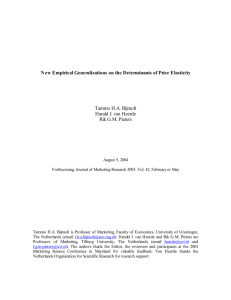pdf version
advertisement
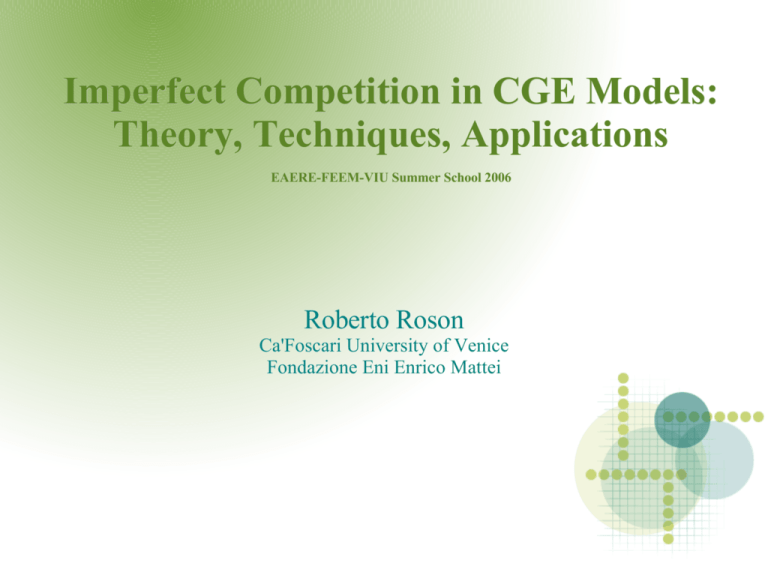
Imperfect Competition in CGE Models: Theory, Techniques, Applications EAERE-FEEM-VIU Summer School 2006 Roberto Roson Ca'Foscari University of Venice Fondazione Eni Enrico Mattei Outline and relevant questions ● ● Why should we adopt alternative assumptions about market structure, in some cases? How can we bridge a partial-equilibrium theory with a general equilibrium approach? ● Which IC paradigm should be chosen? ● How can we compute demand elasticities? ● ● Which extra data is needed to calibrate the model? Is the model output significantly different, and why? Key characteristics of standard CGE models ● Market equilibrium conditions ● Zero profit conditions ● CRS (why?) ● Calibration (its meaning beyond the technique) Where an IC closure may be different ● ● ● Market equilibrium conditions untouched Possible non-zero profits (depending on entry assumptions) => “buffer” effects in price determination Possible economies of scale => market dimension matters ● Calibration with a different interpretation ● Symmetry, aggregation scale No price taking Max = p q q−c q p ' q q− p q− c ' q =0 p−c ' 1 = p =− ● dq/ q dp/ p Individual demand curves contingent on behavioural expectations ● No single model (does it matters?) ● Market elasticities? Deriving price elasticities (1) Deriving price elasticities (2) Deriving price elasticities (3) ● ● ● Nesting (e.g. composite y enters z) Multiple markets (without price discr.) From industry to individual elasticity What is a market? ● ● CGE models with imperfect competition adopt a concept of market based on the origin of trade flows, rather than on their final destination. Competition vis-a-vis ̀ foreign firms is already taken into account through the computation of the industry price elasticity. Therefore, when the firm-level perceived elasticity is derived, only competition from domestic firms has to be accounted for. For example, if Cournot competition is assumed, the number of firms refers to the number of firms active in the domestic origin of trade flows, not in the final destination market. Economies of scale ● ● There can be imperfect competition without economies of scale. However, imperfect competition is needed to accommodate economies of scale in a market equilibrium. One simple way of introducing economies of scale is by assuming that a proportional increase in all factors entails a more than proportional increase in output y, which is equivalent to an increase in the multi-factor marginal productivity. Suppose that the structure of inputs is independent of the output scale; in this case, the cost function (c(y)) is proportional to factor inputs, and there exists a simple relationship between relative variations of total (multifactor) productivity (a), average cost (ac) and marginal cost (mc): Assumptions on profits and data requirements ● Profits are estimated using additional information, breaking down the residual component of the industrial value added; ● ● ● ● Industry mark-ups; Industry elasticities + conjectural variations (e.g., number of firms); Profits are assumed to be initially zero. Profits are assumed to be always zero, because of free entry in the market (monopolistic competition). Does a IC-CGE model perform differently? ● ● ● ● Consider an exogenous increase in production costs IF the profit mark-up stays constant, the impact on the output price should be the same BUT (1) if there are initial profits, the cost shock may actually be larger BUT (2) market and cost shares are endogenously adjusted, and so does the mark-up The effect of changing market and cost shares on elasticities ● Effect #1: market shares. Higher price => increased shares of relatively low elasticity markets => lower industry elasticity => higher mark-up at constant conjectural variations ● Effect #2: cost shares. Ambiguous. ● Effect #1 is likely to dominate Effect #2. ● Cost shocks are amplified in IC ● Even more if there are economies of scale A look at a model TABLO code Set ENDW_COMM # endowment commodities # maximum size 5 read elements from file GTAPSETS header "H6"; SET FIC_ENDW # Fictious Endowment Commodity # (profit); SET EENDW_COMM # Extended Set Endowments # = ENDW_COMM UNION FIC_ENDW ; COEFFICIENT (all,j,PROD_COMM)(all,r,REG) SPLIT(j,r) ! profit share in capital income, in region r and industry j! ; (This is read from outside ad it is used to split the old capital input in two elements) FORMULA ! Sets baseline industry elasticity, aggregating intra-market demand elasticities ! (all,j,TRAD_COMM)(all,r,REG) belaind(j,r) = (QVDM(j,r)/QVOA(j,r)) * CESUBD(j,r) + sum(s,REG, (QVXMD(j,r,s)/QVOA(j,r)) * CESUBM(j,r,s)); EQUATION SETELA ! This equation is a linearized version of the formula above ! (all,j,TRAD_COMM)(all,r,REG) QVOA(j,r)* belaind(j,r) * elaind(j,r) = (QVDM(j,r) * CESUBD(j,r)) * (qds(j,r)-qo(j,r)) + sum(s,REG, (QVXMD(j,r,s) * CESUBM(j,r,s)) * (qxs(j,r,s)-qo(j,r)) ); EQUATION VARIELA ! Determines changes in elasticities, implying subsequent changes in mark-ups. The elasticity elaind(j,r) is computed on the basis of the aggregation of intra-market demand elasticity parameters. As such, it could differ from ela(j,r). The difference is interpreted as due to a conjectural variation parameter. In the case of a symmetric Cournot model, this parameter is 1/n where n is the number of firms. Therefore, if the industry elasticity is elaind, the firm-level elasticity ela is n x elaind. Only the latter matters when determining the mark-up. However, if n stays constant, the percentage change of the industry elasticity is the same as the percentage change of the firm-level elasticity.! (all,j,TRAD_COMM)(all,r,REG) p_ela(j,r) = elaind(j,r); FORMULA & EQUATION SETMUP ! Sets industry mark-up (Lerner index) ! (all,j,TRAD_COMM)(all,r,REG) mup(j,r) = 1/ela(j,r); EQUATION MUPRICING ! Mark-up pricing ! (all,i,FIC_ENDW)(all,j,TRAD_COMM)(all,r,REG) qfe(i,j,r) = p_mup(j,r) + ps(j,r) + qo(j,r) - pfe(i,j,r); An Illustrative Simulation Exercise ● ● ● The GTAP model is a conventional, comparative static CGE model, which can be calibrated with the GTAP database, at any level of aggregation. The structure of the model is fully described in Hertel (1996). We have modified the basic GTAP model, to allow for the possible existence of market power in manufacturing industries. Imperfect competition is introduced according to three alternative formulations (IC1, IC2, IC3), and simulation results are compared with those obtained under the conventional perfect competition closure (PC). We simulate the unilateral removal of all import tariffs and export subsidies for agricultural goods in the EU-25. We assume imperfect competition in manufacturing. Three IC versions ● IC1: constant returns to scale are assumed, Cournot oligopoly, and the number of firms is given. Mark-ups externally estimated. ● IC2: Chamberlinian monopolistic competition, with zero profits, free entry, and economies of scale. Constant ac/mc ratio. ● IC3: similar to IC1, but baseline profit margins, and the number of firms are directly taken from the model calibration data-base. Final Remarks ● ● ● Introducing imperfect competition in a Computable General Equilibrium model entails inserting and adapting concepts originally conceived for partial equilibrium models of Industrial Organization. Not surprisingly, the whole undertaking is not straightforward, as it involves a series of conceptual issues. Although values for some variables may not change very much among the various model versions, distributional effects and welfare impacts do depend quite significantly on the type of model closure. There is not a “right” way of modelling imperfectly competitive industries. Rather, CGE models with market imperfections should be designed in such a way that technical choices are clearly stated, adequately illustrated and justified, on the basis of the specific context of analysis.

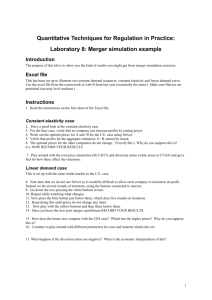
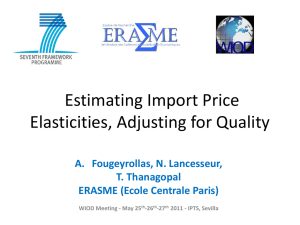
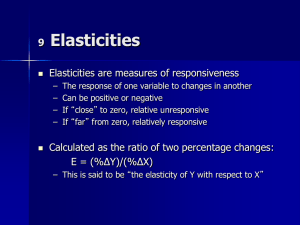
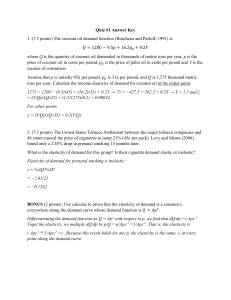
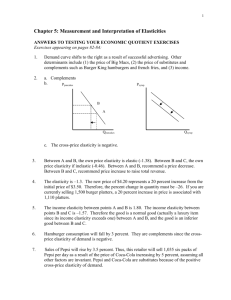
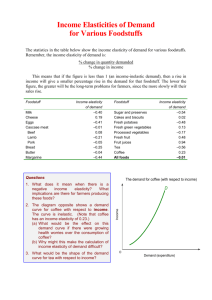
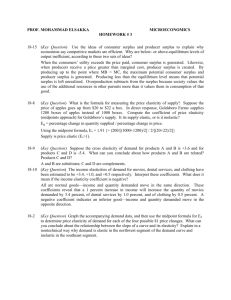

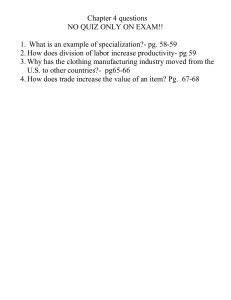
![Level of the Real Exchange Rate and Endogenous Elasticities[*]](http://s3.studylib.net/store/data/008597018_1-597ad2af1e42c05a7ea0fbdacfac5306-300x300.png)
